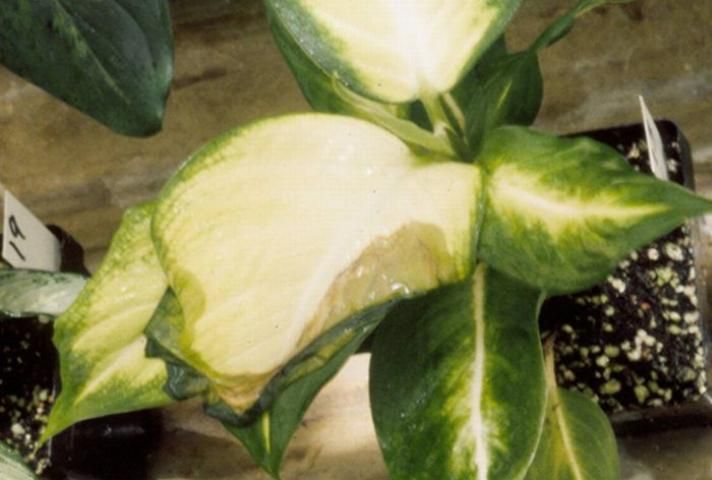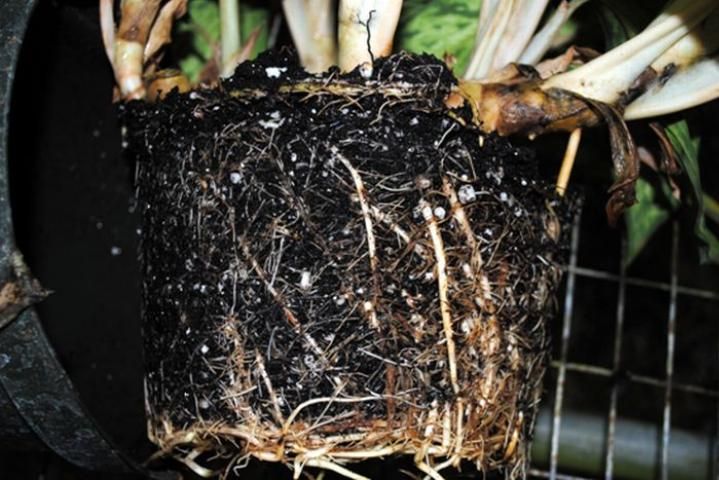Introduction
This article provides guidelines to identify and treat diseases that may be encountered during the commercial production of Dieffenbachia. There are two bacterial diseases and four fungal diseases that growers most often report in their greenhouse environments.
Dieffenbachia
Commonly known as dumb cane, leopard lily, or yalu ni vavalagi, Dieffenbachia is a popular choice for interiorscape plantings, especially in malls and airport installations where its large, striking, variegated foliage is a feature. Therefore, Dieffenbachia is among the top 10 most popular plants produced by commercial foliage growers in Florida. There are more than 30 species and 100 cultivars. Dieffenbachia is in the Araceae (Aroid) family and is native to the Caribbean, Central America, and South America.

In commercial greenhouse production, Dieffenbachia can be propagated by tip cuttings or by division of established clumps from stock plants grown in the ground. Bacterial and fungal diseases can often be rampant under these conditions. Disease-causing organisms (systemic pathogens) can be harbored within stock plant leaf and stem tissues and spread by direct contact with knives and clippers.
During the 1980s, tissue culture propagation technology was introduced to many foliage crops. Disease control, especially prevention of Dasheen mosaic virus, was an early emphasis for tissue culture researchers and pathologists (Henny et al.1981).
Dieffenbachia maculata cv. Perfection 137B was one of the first foliage plants developed by the University of Florida Mid-Florida Research and Education Center in Apopka and released for commercial growers. This Dieffenbachia variety was indexed against Dasheen mosaic virus (Knauss 1976). Because modern facilities now routinely use tissue-cultured, indexed Dieffenbachia as stock, viral diseases are rarely found in commercial production.
Once tissue culture techniques could provide clean stock plants in large numbers, breeding techniques were developed to take advantage of the diversity of foliar variegation, size, and growth habit within the Dieffenbachia genus. In a 10-year period in the 1980s and 1990s, more than 20 new varieties appeared on the market (Henny and Chen 2008). Today, Dieffenbachia breeding focuses on developing disease-resistant varieties to reduce growers' chemical costs.
Bacterial Diseases of Dieffenbachia
Erwinia Blight, Erwinia Soft Rot

Symptoms: Lower leaves of Dieffenbachia turn yellow and spots appear. Rotten spots feel mushy, soft, or watery. Infected areas have a rotten, fishy smell. The spots may enlarge rapidly and the centers of the spots may fall out, leaving holes.
Causal agents: Erwinia carotovora pv. carotovora and Erwinia chrysanthemi
Factors favoring the disease: Erwinia rot is especially acute during warm summer months when there is high relative humidity within greenhouse production facilities. This disease may also increase in severity during winter months when production facilities limit external air exchange, again raising the humidity.
Control and treatment: There are no chemical treatments that can rid infected plants of Erwinia once they have the disease, although compounds containing copper (CuPro, Phyton 27®, Camelot) and mancozeb (Protect T/O™, Dithane®) can help slow the spread of this pathogen. Control of Erwinia is based almost exclusively on sanitation and cultural recommendations: Remove and discard infected plants and leaves showing symptoms at once. Use surface disinfectants such as bleach on clippers and tools. Scrub benches with disinfectant between plantings. Erwinia can grow and persist within soil; therefore, no nonsterile native soil should be added to the planting media. Lower the greenhouse humidity. Increasing ventilation and spreading plant spacing can lower humidity and help decrease the spread and severity of infestations. Lower the frequency and amount of water. If economically possible, replacing overhead watering with drip irrigation on individual pots would further help by eliminating leaf surface moisture and lowering humidity (Norman and Henny 1996).
Xanthomonas Leaf Spot

Symptoms: Leaf spots are very dark, almost black, in color and are surrounded by a yellow halo. Spots start along the leaf edge and enlarge rapidly. If they reach large leaf veins, the leaf will collapse
Causal agent: Xanthomonas axonopodis pv. dieffenbachiae
Factors favoring the disease: Xanthomonas can infest most plants in the Aroid family, including Dieffenbachia, Aglaonema, Anthurium, and Syngonium. Be aware of cross contamination between these crops. Fertilizer studies have shown that poor nutrition favors the disease (Chase 1992). Propagate from clean stock or use tissue-cultured liners. Eliminate all plants showing symptoms. Avoid overhead irrigation, exposure to rainfall, or splashing water.
Control and treatment: The primary mechanisms of a Xanthomonas bacterial infection are via splashing water, contaminated tools, soil, and insects. Worker contact and/ or unsanitary plant handling should also be monitored. Bactericides containing copper compounds (CuPro, Phyton 27®, Camelot), mancozeb (Protect T/O™, Dithane®), and Bacillus subtilis (Cease®, Companion®) can be used successfully to control this disease if used on a regular preventative basis.
Fungal Diseases of Dieffenbachia
Fusarium Stem Rot

Symptoms: Stem turns mushy at the base. The affected area has a reddish or purple discoloration. Tiny bright red fruiting bodies may appear on the bases of severely infected plants. Infected leaves show papery spots with light and dark rings, like a bulls-eye.
Causal agents: Fusarium solani or Fusarium oxysporum
Because Fusarium stem rot symptoms (fungus) look very similar to Erwinia soft rot symptoms (bacteria), accurate identification prior to selection and application of chemicals is key.
Factors favoring the disease: Fusarium usually enters a greenhouse operation and becomes a problem via infected propagation material or contaminated soil. Workers, equipment, and clippers can contribute to secondary spread.
Control and treatment: Use indexed starting materials from tissue culture or stock plants known to be free of disease. Treat cuttings with a fungicidal dip prior to sticking. After sticking, drench cuttings with a fungicide (OHP 6672™, Cleary's 3336®). Remove infected plants as soon as the disease is detected. Do not reuse the soil or the container.
Anthracnose Leaf Spot

Symptoms: Tan, water-soaked spots appear with a yellow halo along the leaf edge. Look for black specks in concentric rings within the spot. These are the spores that spread the disease. The Colletotricum fungus is a weak opportunistic pathogen frequently observed after fertilizer or pesticide damage.
Causal agent: Colletotrichum gloeosporioides
Factors favoring the disease: Condensation dripping from the glass or plastic roof overhead will splash the spores and spread the disease. The disease favors cool temperatures.
Control and treatment: Keep foliage dry. Irrigate early enough in the day for Dieffenbachia foliage to dry quickly. Do not let water sit on the leaves overnight since the disease favors cool temperatures. Maintain greenhouse heat and ventilation systems.
Fungicides containing mancozeb (Protect T/O™, Dithane®) can control Anthracnose leaf spot.
Myrothecium Leaf Spot and Petiole Rot

Symptoms: Petiole rot on older leaves. Leaf spots appear anywhere leaves are wounded, especially at the leaf tips and along breaks in the main vein. On the underside of the leaf, black and white fungal fruiting bodies and spores are almost always present in a circular pattern.
Causal agent: Myrothecium roridum
Factors favoring the disease: Newly planted tissue-cultured plants are very susceptible to this disease.
Control and treatment: Monitor worker handling to avoid breaking plant tissues. The fungus gains access through wounds. Keep the foliage as dry as possible. Water early in the day and provide good air circulation. Strobilurin fungicides (Heritage®, Compass™, Insignia®, Disarm®, FenStop™) and fludioxonil (Medallion®) provide the best control of this disease.
Phytophthora Stem and Root Rot and Leaf Spot

Symptoms: Infected roots turn brown and deteriorate rapidly.
Causal agents: Phytophthora spp.
Factors favoring the disease: This disease occurs if plants are placed on the ground or grown in the ground.
Control and treatment: Grow plants on raised benches. Do not place plants on the ground soil at any time. Fosetyl-al (Aliette®), metalaxyl (Subdue® MAXX®), dimethomorph (Stature®), fluopicolide (Adorn™), and phosphorous acid (Alude™, K-Phite®, Vital®) provide very good control.
Note: The use of trade names in this publication is solely for the purpose of providing specific information. UF/IFAS does not guarantee or warranty the products named, and references to them in this publication do not signify our approval to the exclusion of other products of suitable composition. Use pesticides safely. Read and follow directions on the manufacturer's label.
References
Chase, A. P. 1992. "Common Diseases of Dieffenbachia." Southern Nursery Digest. 26 (12): 20–21.
Henny, R. J., and J. Chen. 2008. Tropical Foliage Cultivar Development: New Ornamental Introductions Drive Plant Markets. ENH1093. Gainesville: UF/IFAS. https://edis.ifas.ufl.edu/EP357.
Henny, R. J., J. F. Knauss, and A. Donnan, Jr. 1981. "Foliage Plant Tissue Culture." In Foliage Plant Production, edited by Jasper N. Joiner, pp. 137–178. Englewood Cliffs, NJ: Prentice-Hall.
Knauss, J. F. 1976. "A Tissue Culture Method for Producing Dieffenbachia picta cv. 'Perfection' Free of Fungi and Bacteria." Proc. Fla. State Hort Soc. 89: 293–296.
Norman, D. J., and R. J. Henny. 1996. "Xanthomonas and Erwinia Resistance in Twenty Dieffenbachia Cultivars." UF/IFAS Central Florida Research and Education Center Research Report RH-96-9.